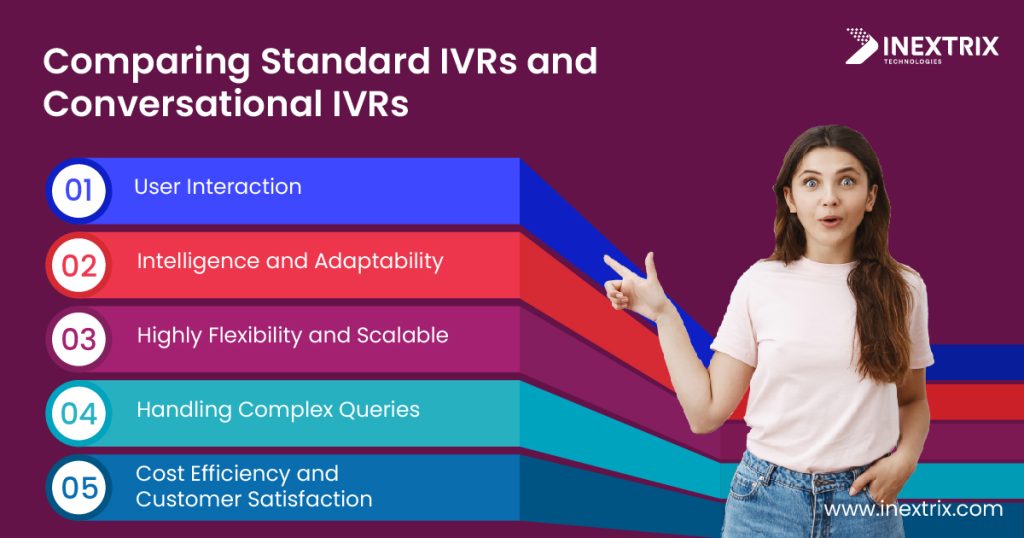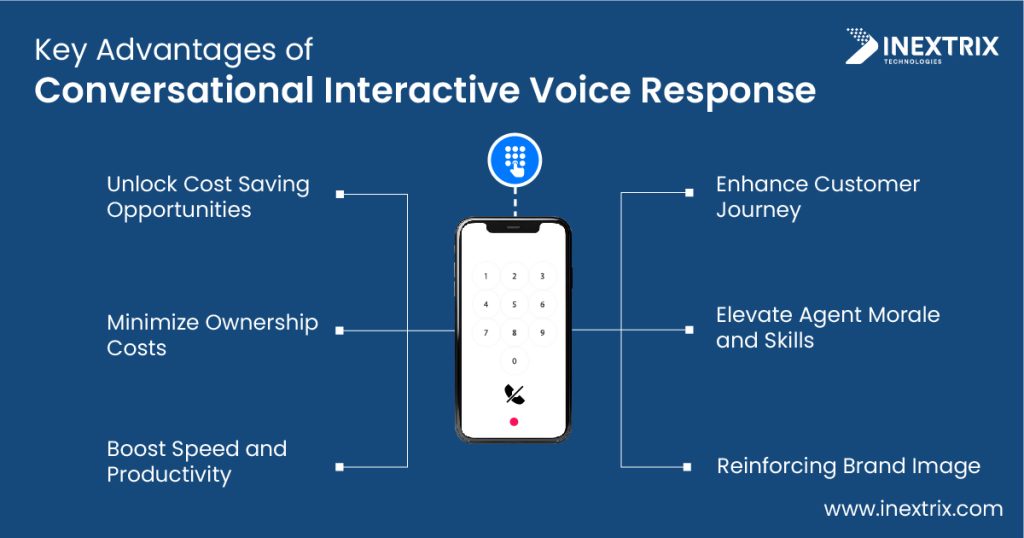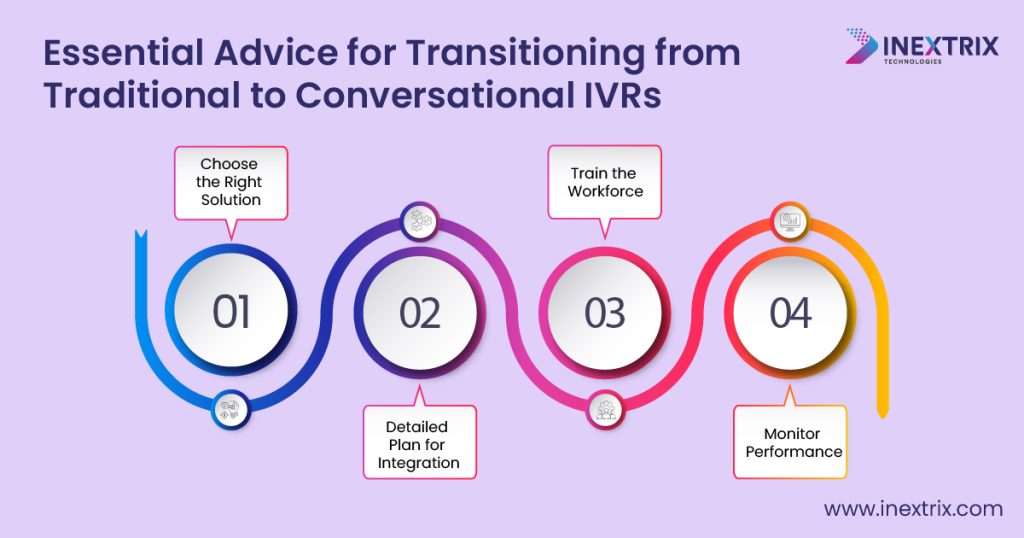The role of Interactive Voice Response (IVR) in the customer support department is irreplaceable. For several years, customer care teams and departments have used IVRS to provide self-serving options to clients. Over the years, several innovations have taken place to make this self-serving solution more engaging and useful for clients. Certainly, a significant evolution emerges from the traditional to the conversational IVR systems. Gone are the days when navigating through a series of robotic commands and pressing numerous buttons to reach a human operator was the norm. Today, Conversational IVRS stands at the forefront of revolutionizing customer interactions to offer a stark contrast to its standard counterpart.
This advanced IVR system leverages Artificial Intelligence (AI) and Natural Language Processing (NLP) to understand, engage, and solve customer queries in a more intuitive and human-like manner. As businesses strive to meet and exceed the increasing expectations set by service giants, understanding the distinct differences between Conversational and Standard IVR becomes crucial. This exploration will highlight the technological advancements and it will shed light on the shifting dynamics of customer service, where efficiency, personalization, and understanding are paramount.
Elevate your call center experience with our customized Conversational IVR systems.
Without any further delay, let’s delve deeper into this subject matter to understand both types of IVR solutions and how conversational solutions give a competitive edge to its users.
1. What is a Standard IVRs?
A standard Interactive Voice Response System is a sophisticated telephony solution that automates interactions between callers and a phone system. Now, this solution is available as a web app or builtin feature within the software. At its core, IVRS uses pre-recorded voice prompts to create a dialogue with users, enabling them to access information or navigate a company’s services through voice commands or inputs from their phone’s keypad.
The system operates by greeting callers with a menu of options, such as “Press 1 for Sales, Press 2 for Support,” and so on. The caller’s response, either through voice or keypad entry, triggers the IVRS to play the relevant pre-recorded information, transfer the call to a specific department, or perform a particular action based on the programmed workflow. This technology leverages Dual-tone Multi-frequency (DTMF) signaling, which corresponds to the keypad inputs, and in more advanced systems, voice recognition capabilities.
Standard interactive voice response solutions are designed to handle high call volumes efficiently. Moreover, it reduces the need for direct human intervention and enables organizations to allocate their human resources to more complex tasks or inquiries. They are widely used across various industries for purposes such as customer support, appointment booking, bill payments, surveys, and more.
Despite their efficiency, standard IVRS has several limitations. Primarily, in their rigid menu structures and limited understanding of nuanced human speech, which can sometimes lead to caller frustration, especially, if the system fails to recognize or appropriately respond to the caller’s needs. Nonetheless, they remain a fundamental component of modern customer service and operational frameworks. It provides a scalable and cost effective means of managing customer interactions.
Key Features of Standard IVRs
- Pre-recorded voice prompts
- DTMF (Dual tone multi-frequency) input
- Voice recognition
- Customizable menus
- Automated information retrieval
- Queue management
- Call routing
- Integration capabilities
- Analytics and reporting
2. What is a Conversational IVRs?
It is an advanced form of the traditional IVR solution. Certainly, it incorporates cutting-edge advancements in artificial intelligence (AI), machine learning (ML), and natural language processing (NLP). This sophisticated system transforms the way callers interact with automated phone systems, moving from a rigid, menu-driven approach to a fluid, conversation-like experience.
Let’s take a look at three major technology components incorporated into the conversational IVR:
Artificial Intelligence and Machine Learning Integration
Conversational IVRS embedded AI and ML to ensure they evolve with each interaction. Certainly, these systems continuously learn. So, they increasingly master the subtleties of language, refine their prediction of caller intentions, and sharpen the accuracy of their responses. This ongoing learning process significantly boosts their effectiveness and reliability.
Natural Language Processing (NLP)
At the core of conversational IVRS lies its remarkable ability to grasp spoken language just as it flows in everyday conversations. Moving beyond the constraints of standard IVR systems, which demand specific phrases or keypad inputs, conversational IVRS seamlessly interprets a broad spectrum of verbal cues. As a result, this shift does not make interactions more intuitive and significantly broadens the scope for user engagement.
Dynamic Response Generation
Harnessing the power of AI, conversational interactive voice response systems dynamically craft responses in real time, meticulously tailored to match the specific query or the context of each call. Consequently, every caller receives precisely the information or support they need. How does a CRM integrated Asterisk IVR solution benefit businesses? This solution greatly elevates the overall customer service experience.
Key Features of a Conversational IVRS
- Self-learning capabilities
- Seamless routing to human agents
- Voice biometrics
- All features of a standard IVRS
- Analytics and reports
3. Difference Between Standard and Conversational IVRs

Certainly, standard and conversational interactive voice response solutions have their own advantages to offer. Let’s compare the difference between both for major criteria.
User Interaction
Standard IVR systems rely on predefined menus and dialpad inputs. It requires users to navigate through options with limited flexibility. On the other hand, conversational interactive voice response solutions adopt a more intuitive approach. Firstly, it employs natural language processing (NLP) to allow users to express their needs using their own words. For example, they don’t need to just to Press 1 or Press 2. Rather they can explain what the exact concern is. As a result, the conversational system brings a paradigm shift, which greatly enhances user experience, making interactions smoother and more natural.
Intelligence and Adaptability
The standard solution operates within a fixed framework. Therefore, it is unable to learn or adapt from interactions. Conversely, the conversational system, infused with artificial intelligence (AI) and machine learning (ML), evolves continuously. Firstly, it learns from each conversation. Secondly, it improves its ability to understand nuances and predict user intent. As a result, it offers personalized responses and makes it a far more effective solution for dynamic customer engagement.
Highly Flexibility and Scalable
Mostly, updating a standard system to accommodate new services or options is cumbersome and time-consuming. In contrast, a conversational solution shines with its flexibility. Undoubtedly, it allows smooth update processes. Moreover, it is highly scalable so that it matches business growth or changes without the need for extensive reprogramming. Therefore, conversational IVRS positions itself as a more agile and future-proof choice.
Handling Complex Queries
Standard systems often fail when they have to manage complex queries. Therefore, it leads to customer frustration and increased call transfers to human agents. On the other hand, the conversational solution excels in managing complex inquiries thanks to its advanced AI capabilities. Unquestionably, it provides accurate, context-driven solutions in real time. As a result, it significantly reduces the need for human intervention and streamlines the customer service process.
Cost Efficiency and Customer Satisfaction
Initially, standard interactive voice response solutions were praised for their cost saving potential. Yet, conversational IVR extends beyond mere cost reduction, directly contributing to higher customer satisfaction through personalized and efficient interactions. As a result, it increases customer loyalty and enhances brand reputation. Therefore, conversational IVRS is an investment in customer relations as much as it is in technology.
4. Top Benefits of Conversational Interactive Voice Response

There are several advantages of using conversational IVRS than a traditional IVR solution. Let’s take a look at the top 5 benefits of using conversational solutions.
Unlock Cost Saving Opportunities
Conversational systems automate customer interactions and redefine cost efficiency. It directly translates into significant operational savings. Moreover, it minimizes the reliance on extensive customer service teams. Businesses can reallocate financial resources to other critical areas. As a result, it optimizes their overall expenditure and boosts profitability.
Minimize Ownership Costs
Typically, choosing conversational technology leads to a more favorable total cost of ownership (TCO) compared to traditional systems. These advanced solutions are built for scalability. Therefore, it reduces the need for constant upgrades. Furthermore, their effectiveness in managing customer inquiries diminishes the demand for human resources. As a result, it further drives down the long term operational costs.
Boost Speed and Productivity
Integrating AI and natural language processing, conversational systems excel in swiftly understanding and addressing customer requests. This immediate processing capability shortens call durations and enables businesses to manage a larger volume of inquiries efficiently. Therefore, it significantly enhances operational productivity.
Enhance Customer Journey
Unquestionably, transitioning to a conversational system marks a significant leap in customer service quality. Customers enjoy more natural interaction, free from the constraints of rigid menu systems, leading to a smoother, more enjoyable experience. Certainly, this personalized approach fosters higher levels of customer satisfaction and loyalty.
Elevate Agent Morale and Skills
Certainly, the conversational interactive voice response solution automates routine queries. Therefore, the conversational solution alleviates the agents’ workload. As a result, the system allows them to concentrate on resolving more intricate customer issues. This shift improves their job satisfaction by focusing on more engaging tasks. Moreover, it accelerates their professional development within the field of customer service.
Reinforcing Brand Image
Implementing a conversational system showcases a brand’s dedication to leveraging cutting-edge technology for superior customer service. This commitment to innovation and quality service enhances the brand’s reputation. Therefore, it distinguishes it from competitors and fosters stronger customer relationships.
5. Top Tips to Switch from Traditional to Conversational IVRs

It is advisable to use a strategic approach to implement conversational interactive voice response systems. Here are the steps and tips that you must follow for a swift transition from a traditional solution to a conversational solution.
Choose the Right Solution
Certainly, the market is crowded with so many options of conversational IVRS. Therefore, you must invest time in research to select a conversational solution that aligns with your business requirements. Firstly, you must look for features like scalability, ease of integration, support for multiple languages, and advanced AI capabilities. Secondly, you need to check how flexible the solution is to meet your personalized business needs with customization. Finally, the cost matters. So, you must check how cost effective the solution is that you are interested in buying.
Detailed Plan for Integration
Undoubtedly, the beauty of using a conversational IVRS is its flexibility to support integration of other third party tools and solutions. To make a swift transition, you must develop a detailed plan for integrating the conversational IVRS into your existing systems. Certainly, this plan should include technical requirements, a timeline, a budget, and any potential challenges that might arise during the transition.
Train the Workforce
Generally, IVRS work independently. Therefore, agents and other team members might not need to learn about this solution. However, the administrative or technical team that will make the configuration will need to make the changes in IVR menus and other settings. Therefore, to ensure your staff is well prepared for the switch, you must provide comprehensive training on the new system. Focus on how the conversational system works, how to manage and update it, and how to troubleshoot common issues.
Monitor Performance
Regularly monitor the system’s performance to ensure it meets your customer service goals. Look at the major KPIs such as first call resolution rates, customer satisfaction scores, and average handling times to gauge its effectiveness. All this data will help you define how greatly the system is performing.
Concluding Note
In essence, conversational interactive voice response solutions stand as a pivotal technology for businesses aiming to revolutionize their customer service approach. It propels operational efficiency and customer satisfaction to new heights. Moreover, it significantly contributes to brand strength and market competitiveness. This modern IVR solution presents a transformative opportunity for businesses to elevate their customer and agent experiences, streamline operations, and reinforce their brand identity. At the same time, businesses can achieve significant cost savings and operational efficiencies. We provide a conversational IVR solution and development services. To learn more about our offers, get in touch now.
